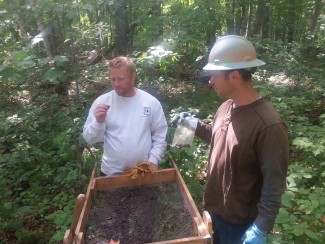Discover History
Over 3000 heritage sites have been identified within the Chippewa National Forest boundary; 1800 of these located on National Forest System lands. Most of these sites have been identified through heritage surveys. Heritage sites include archaeological sites, historic buildings, and places of historic or cultural significance. The Forest averages 3000 to 5000 acres of heritage survey each year for 80-100 project areas. Common projects requiring surveys include timber sales, creating wildlife openings, utility installations, land exchanges, prescribed burns and building development or maintenance.

Heritage sites are typically excluded from project areas to avoid harming them. If this is not possible, the site is evaluated to determine if it meets the criteria for eligibility to the National Register of Historic Places. The evaluation may include archaeological excavation, detailed documentation of the structure, or additional historic research as well as consultation with the Leech Lake Tribal Historic Preservation Office, the Minnesota State Historic Preservation Office, and other heritage professionals and practitioners. The National Register’s criteria consider the site’s age (a heritage site must be at least 50 years old), integrity (how well preserved it is), and significance (what is the site’s potential to provide information about the past). The Chippewa National Forest is fortunate to be able protect our heritage sites from projects that may have impacted them.
The Forest has over 50 National Register eligible buildings and places on the Chippewa National Forest including 6 National Register listed sites and 1 National Historic Landmark (Rabideau Civilian Conservation Corps (CCC) Camp). Visit some of these Historic Sites and Landscapes.
There are other ways you can engage with "the past" on the Chippewa National Forest. The public has been able to participate in archaeological projects through the Passport in Time program and the Chippewa National Forest’s Youth Archaeology Workshop. These projects have led to determining National Register eligibility of archaeological sites as well as helped us learn

more about how people in the Headwaters Region lived in the past. Likewise, building restorations, such as: Joyce Estate, Old Cut Foot Sioux Ranger Station and Rabideau CCC Camp have provided opportunities for individuals and organizations to participate and learn about preservation techniques, local history and Forest Service heritage management.
Some unique and representative cultural resource sites are interpreted and easily accessed by visitors to the Chippewa National Forest. Educational resources are also available.



